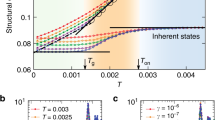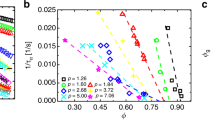Abstract.
We introduce a three-dimensional lattice gas model to study the glass transition. In this model the interactions come from the excluded volume and particles have five arms with an asymmetrical shape, which results in geometric frustration that inhibits full packing. Each particle has two degrees of freedom, the position and the orientation of the particle. We find a second order phase transition at a density \(\rho\approx 0.305\), this transition decouples the orientation of the particles which can rotate without interaction in this degree of freedom until \(\rho = 0.5\) is reached. Both the inverse diffusivity and the relaxation time follow a power law behavior for densities \(\rho\le 0.5\). The crystallization at \(\rho = 0.5\) is avoided because frustration lets to the system to reach higher densities, then the divergencies are overcome. For \(\rho > 0.5 \) the orientations of the particles are coupled and the dynamics is governed by both degrees of freedom.
Similar content being viewed by others
References
M. Mézard, Physica A 306, 25 (2002), preprint cond-mat/0110363
W. Götze, in Liquids, Freezing and Glass Transition, edited by J.P. Hansen, D. Levesque, P. Zinn-Justin (Elsevier, Amsterdam, 1991)
P.G. De Benedetti, F.H. Stillinger, Nature (London) 410, 267 (2001); J.P. Sethna, J.D. Shore, M. Huang, Phys. Rev. B 44, 4943 (1991)
D.S. Gaunt, M.E. Fisher, J. Chem. Phys. 45, 2482 (1966); W. Ertel, K. Froböse, J. Jäckle, J. Chem. Phys. 88, 5027 (1988)
G.H. Fredrickson, H.C. Andersen, Phys. Rev. Lett. 53, 1244 (1984); J. Chem. Phys. 83, 5822 (1985); W. Kob, H.C. Andersen, Phys. Rev. E 48, 4364 (1993)
I.S. Graham, L. Piché, M. Grant, Phys. Rev. E 55, 2132 (1997)
M. Nicodemi, A. Coniglio, Phys. Rev. E 57, R39 (1998)
M. Pica Ciamarra, M. Tarzia, A. de Candia, A. Coniglio, Phys. Rev. E 67, 057105 (2003)
G. Biroli, M. Mézard, Phys. Rev. Lett. 88, 025501-1 (2002)
A. Coniglio, Nuovo Cimento D 16, 1027 (1994); A. Coniglio, Proceedings of the international School of Physics “Enrico Fermi” (Course CXXXIV) (IOS Press, Amsterdam, 1997)
A. Barrat, J. Kurchan, V. Loreto, M. Sellitto, Phys. Rev. E 63, 51301 (2001)
A. Dí az-Sánchez, A. de Candia, A. Coniglio, J. Phys. A: Math. Gen. 35, 3359 (2002)
E. Caglioti, V. Loreto, H.J. Herrmann, M. Nicodemi, Phys. Rev. Lett. 79, 1575 (1997)
K. Froböse, J. Stat. Phys. 55, 1285 (1989); J. Jäckle, K. Froböse, D. Knödler, J. Stat. Phys. 63, 249 (1991)
C. Donati, S. Franz, G. Parisi, S.C. Glotzer, J. Non-Crys. Solids 307, 215 (2002)
Author information
Authors and Affiliations
Corresponding author
Additional information
Received: 20 October 2004, Published online: 23 December 2004
PACS:
64.70.Pf Glass transitions
A. Díaz-Sánchez: Also at: Dipartimento di Scienze Fisiche, Universitá di Napoli “Federico II”, Complesso Universitario di Monte Sant’Angelo, Via Cintia, 80126 Napoli, Italy and INFM, Unitá di Napoli, Napoli, Italy
Rights and permissions
About this article
Cite this article
Díaz-Sánchez, A. Decoupling-coupling of rotations as a mechanism of glass transition. Eur. Phys. J. B 42, 391–396 (2004). https://doi.org/10.1140/epjb/e2004-00395-2
Issue Date:
DOI: https://doi.org/10.1140/epjb/e2004-00395-2




